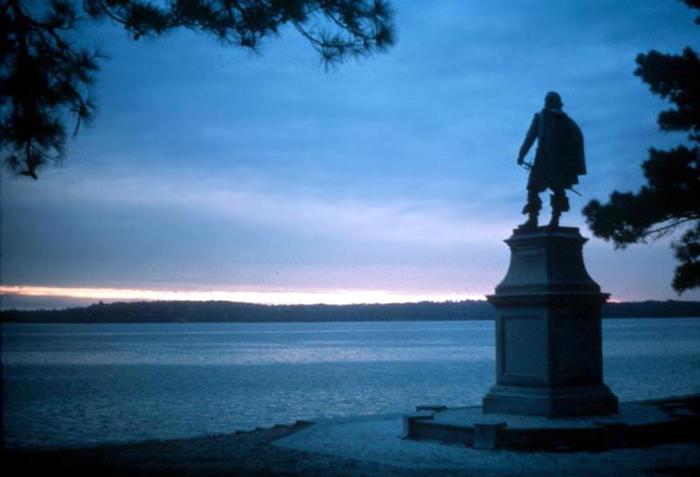
Unless the course is reversed, this statue of Captain John Smith at Jamestown might one day soon be gazing out at a 7-mile-long stretch of 300-foot-tall electrical transmission towers/NPS
Editor's note: This story has been updated to remove a reference that there are less costly alternatives to the chosen route.
Most, if not all, elementary school children in the United States today learn about Virginia's Jamestown, Captain John Smith, and how Pocahontas purportedly saved his life during the winter of 1607-08.
By the time those students reach high school, they might also study a battle over a towering, 7-mile-long electrical transmission line that encroached on the historic setting of Jamestown, possibly damaged archaeological settings and cultural artifacts left by Native American tribes that lived in the region, and invaded the habitat of a prehistoric fish now considered endangered.
The battle, if it comes to that, is just in early skirmishes. While Dominion Virginia Power maintains that its proposed Surry-Skiffes Creek-Whealton Transmission Line, which would cross the James River between Surry and James City counties, is the best way to maintain a healthy power grid in the area, groups including the National Trust for Historic Preservation, the National Parks Conservation Association, and Preservation Virginia maintain there are less-damaging solutions that wouldn't need to span the river and invade the historic setting.
“No one thinks of this as a good project. That hasn’t changed," Sharee Williamson, the associate general counsel for the National Trust for Historic Preservation, said during a phone call Wednesday. "The (memorandum of agreement) was signed last week, but I think it’s important to point out to your readers that although it was signed by the relevant state and federal government agencies, there’s not a single public interest group that’s signed onto that agreement. And that’s because there’s no amount of money that is sufficient to mitigate the harm when you’re talking about damaging one of the most historic places in the United States. James River, Jamestown, is priceless.”
The Interior Department's position on the transmission line project changed when President Trump took office.
Former National Park Service Director Jon Jarvis, who retired at the start of the year, had said in a letter to the Army Corps of Engineers that the project, which would cross the James River within sight of Historic Jamestowne and Colonial National Historical Park, would cause "severe and unacceptable damage to this historically important area and the irreplaceable and iconic resources within it."
"Running power lines through the landscape where the earliest days of American history were written will forever change the ability of Americans to experience and understand our nation's earliest day," the letter also pointed out.
Sally Jewell, President Obama's Interior secretary, in one of her last tasks in that role wrote the Army Corps of Engineers on January 17 to express her concerns over the project.
Not quite three months later, new Interior Secretary Ryan Zinke sent a follow-up letter to the Corps, stating that he had reviewed his predecessor's letter and concerns, considered the Corps' response to them, and concluded that the project could safely proceed.
"The Department stands ready to sign a final agreement as a concurring party and work with the other signatories to carry out its term," Secretary Zinke wrote on March 30.

This map prepared by the National Parks Conservation Association shows where the proposed transmission line would run and how close it would be to various units of the National Park System/NPCA
The memorandum of agreement was signed last week. That 69-page document does not authorize the project, but stipulates what mitigations the power company must take if it eventually receives all the requisite permits. The Corps is expected any day now to issue a 404 Permit needed by Dominion Virginia Power to work in the James River.
The groups opposed to the project have asked the Army Corps to require that an environmental impact statement be prepared on the project, but have no idea whether the agency will agree.
“We have for four years held a belief that an environmental impact statement needs to be undertaken to really review and evaluate the alternatives that would both preserve the historic, cultural, and scenic character of the region while being able to deliver the needed electric power to the peninsula," said Elizabeth S. Kostelny, executive director of Preservation Virginia. The group's ties with Jamestown Island goes back to 1893, when it acquired 22 acres on the island; today, the organization works alongside the National Park Service to preserve and interpret Historic Jamestowne.
“That particular stretch of the river is very well-preserved. There are indigenous cultural sites along the riverbank yet to be fully documented," she noted during a phone conversation. "There are archaeological remains, and there’s a real well-preserved experience for the traveler of the river. With the establishment of the (Captain John Smith Chesapeake National Historic Trail), we’re seeing a lot more of that kind of heritage/ecotourism in the region. And this (transmission project as designed) will diminish the integrity of that significantly for those people that are using the river or the (Colonial) Parkway."
Central to the issue is the move by Dominion to decomission two coal-fired power plants at Yorktown in Surry County. While the utility sees a future where more power will come from solar and nuclear, until that day, it needs to shore-up its power grid, and the transmission line is key to that move.
The memorandum calls for Dominion to spend nearly $100 million on mitigation projects that will "support, preserve, and/or enhance the historic character or viewshed of the Jamestown Settlement" and provide additional educational and interpretive programs to seawalls to protect Fort Monroe National Monument from sea level rise and efforts to "ensure that human skeletal remains and associated funerary objects encountered ... (are) treated in accordance with the Regulations Governing Permits for the Archaeological Removal of Human Remains."
Yet despite the many pages outlining the mitigation steps, the document has not mollified groups that were consulted as required under Section 106 of the National Historic Preservation Act.
"As you know, the majority of consulting parties believe the adverse effects of this undertaking on the nationally significant historic properties cannot be appropriately mitigated," wrote Reid Nelson, director of the Office of Federal Agency Programs for the Advisory Council on Historic Preservation, in a May 2 letter to the Corps. "It is our hope that the studies and projects required by the MOA will limit long-term and cumulative effects and ultimately lead to the reversal of the direct and indirect effects by placing the overhead transmission line with a buried line under the James River."
At the National Trust for Historic Preservation, Ms. Williamson on May 2 wrote the Corps a 53-page letter outlining why that organization believes the Corps failed to meet the requirements under the National Environmental Policy Act. Noting that the Trust had hired a Boston engineering firm that came up with a handful of alternatives that would meet the utility's stated goals without the need for a river-crossing transmission line, and that those alternatives were summarily dismissed, she wrote that, "(T)he Army Corps’ and Dominion’s stonewalling and failure to share information is inappropriate. Basing a permit decision on research conducted behind closed doors in an untransparent process simply does not comply with NEPA’s review requirements. Preparation of an EIS would allow the full and public review of project alternatives that NEPA requires."
"We’ve asked for years for an EIS to be prepared and pointed out the multiple national park unit resources, the national trail, the historic landmark, Carter’s Grove," the legal counsel said Wednesday. "We pointed out that the segment of the river is listed on the nationwide rivers inventory under the Wild and Scenic Rivers Act and, more and more, how important this region is to Virginia's tourism economy, and still we’ve just not gotten any response from them.
“And so, just reading the tea leaves … they seem poised to make a decision on the permit soon, and given that they haven’t started an EIS process yet, I would be pleasantly surprised if they move forward with an EIS," she added.
The following video created by the National Trust for Historic Preservation depicts how the transmission line would appear if built.
Much the same sentiment was shared by Joy Oakes, senior director of NPCA's Mid-Atlantic Region.
"I don’t think anyone can say this was the best effort by a federal agency to avoid harming a resource of national significance like Jamestown," she said.
While the utility's position on historic character has been that the river corridor has been "industrialized" by development, Ms. Oakes disagreed.
“If you got in a boat, and if John Smith was in a boat next to you, and if Chief Powhatan was in another boat, those two would know where they were today. No one would say it's pristine," she said, but "it’s evocative of that time, 400 years ago, when Jamestown was founded."
Stringing transmission lines 7 miles across the James River, with 17 of 44 towers being placed in the river itself, would do irreparable damage at least to the historic setting if not to archaeological and cultural resources, maintained Ms. Oakes.
"Some of them would be as tall as almost 300 feet, as tall as the Statue of Liberty. Now, you can say, 'Well, I’ve been to New York, I've seen the Statue of Liberty, she doesn’t seem that tall.' But of course she’s against the skyline of Manhattan, so she’s going to look fairly petite," the NPCA official said. "But in a landscape where the trees are 60 feet tall, 300 feet stands out. With bright lights on it so small planes don’t hit it, it’s going to stand out.”
Also in harm's way is an endangered population of Atlantic sturgeon, a prehistoric relic of a fish that comes up the James and York rivers twice a year to spawn. The National Marine Fisheries Service has proposed that the James River from Richmond down to the Chesapeake Bay be designated as critical habitat for the sturgeon, and a decision is expected in June.
But as the Interior Department has, from the Obama administration to the Trump administration, reversed its stance on the transmission line project, there's curiosity among observers as to whether the Marine Fisheries Service might reverse itself as well.



Comments
Imagine if this went within 3 miles of Mara Largo. You can be sure it would be swiftly rejected.
Yes, imagine. However, this is hardly unique to the Trump Administration. Years ago, the good people of New Jersey fought another monstrosity crossing the Delaware Water Gap National Recreation Area. What did Mr. Obama do about it? Nothing. Here is a link to an article explaining that: I believe The Traveler also covered the issue.
http://www.poconorecord.com/article/20140513/NEWS90/405130318
If you want to stop power lines, you had better stop growth. Huge power lines are in the works all across the West for wind and solar projects. The entirety of southern New Mexico is about to become a gigantic wind farm, also southeastern Wyoming. Tens of thousands of turbines are planned, linked to southern California by new lines. I know; you would all like to blame Donald Trump, but get serious for a change. All of this started decades ago when the United States--and the world--refused ZPG.
I love Jamestown; these towers should not be built. But again, they will be built somewhere is the point of growth.
Delaware Water Gap. The parallels here are striking.
https://www.nationalparkstraveler.org/2010/02/power-line-debate-delaware...
https://www.nationalparkstraveler.org/2010/03/groups-argue-against-trans...
https://www.nationalparkstraveler.org/2010/08/park-service-says-no-prede...